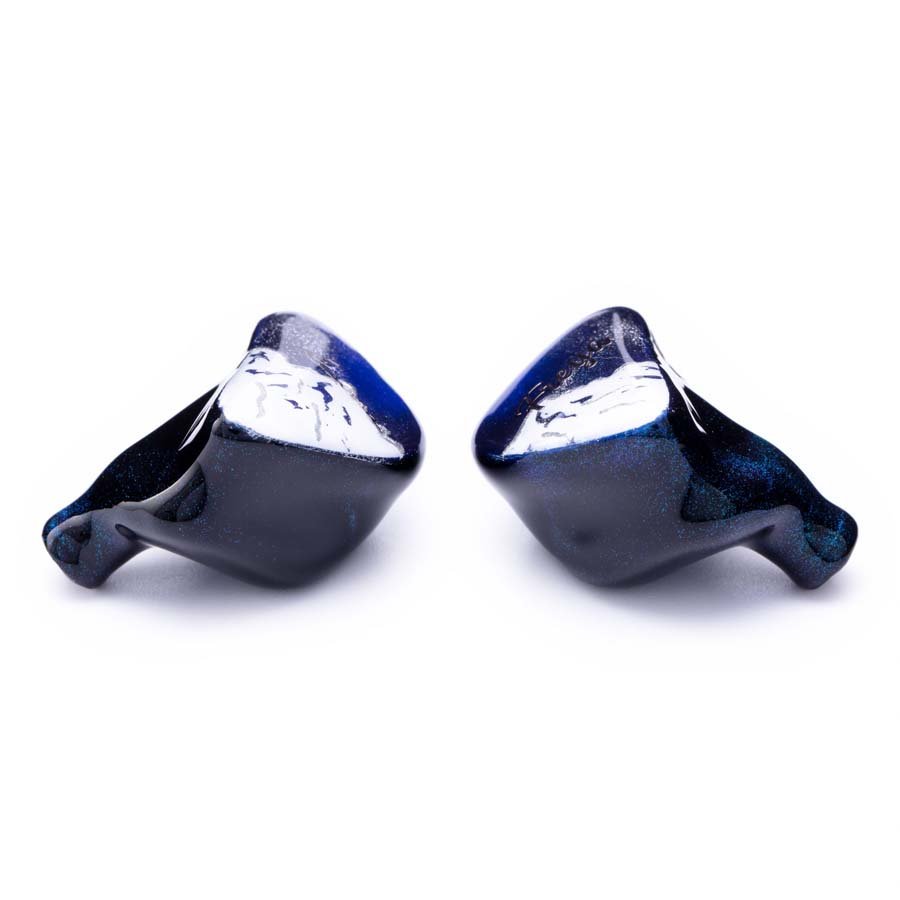KINERA FREYA IEM REVIEW
Janine Elliot takes a listen to Chinese brand Kinera’s Freya IEMS costing £219.

I was sent a hexagonal package that looked very much like an expensive box of chocolates. I was rather excited, thinking it must be my birthday, and when I opened it up I was additionally impressed with the contents; two beautifully hand-designed IEMs and a patterned leatherette box (that could have equally worked as a box of truffles) full of cabling and accessories to assemble the monitors and begin my listening. I must reiterate the build quality was quite amazing for an IEM that looked £1000+ but actually came in at £219. Like all the in-ear monitors coming from the Chinese company Kinera, these are individually hand-assembled and painted, with each one initially hand-sketched and then hand-painted by the Kinera skilled designer, designed to match the personality of the Goddess Freya.
HISTORY
Kinera’s history goes back to 2011 when YuTai Electronic Acoustics was established. Work included a 5mm micro armature speaker for hearing aids and then mass producing armature drivers and developing bone conduction driver technology. The Kinera brand name was established in 2016, starting a series of hybrid driver IEMs. Today the website shows off the three multi-driver IEMs including entry-point Freya. With a motto “Live only for honour” these IEMs should warrant a promising listening voyage.
CONSTRUCTION
Freya utilizes a multi-unit hybrid design with a single dynamic driver combined with three balanced armatures. It employs an internal crossover to send low, mid, and high frequencies to each dedicated driver – meaning the sound should be well balanced. Kinera supply a 7mm micro-dynamic driver to offer a deep bass extending to 20Hz. Knowles Balanced Armature drivers deploy sound to the mids and highs; two Knowles balanced armature drivers RAF-32873 deliver midrange and Kinera’s customized BA 30095 driver produces the well extended and balanced treble all the way up to 20kHz. This is a well-proven combination set-up on multi-driver IEMs. With a sensitivity of 110dB I found these very efficient earphones, having to keep the volume quite low on my headphone amplifier. The overall build quality is exemplary, only the cabling being more rigid than I would have liked, but it is the same cabling as seen in their expensive Nanna IEM. The high OFC cable has 0.78mm 2-pin connectors to the IEMs and 3.5mm at the other end. The bountiful accessories include ¼” adaptor, type C to 3.5mm and Lightning to 3.5mm adaptors, a set of eight S, M or L silicone ear-tips in black and white (the white ones look so much better!), and the waterproof circular storage box to put the IEMs in when on the move. The gloss finish on the earpieces is some of the best I have ever seen. Indeed, three months of intensive research went into experimenting with different materials and hand painting techniques to arrive at the optimum painting materials and combination of colours. All it needed now was a sound quality to match.
THE SOUND
I have very small ears, but I managed to fit these fairly large earpieces in my ears, using the cabling to go over the ear to help keep it all secure. My source was the Fiio X5 using the line-out connected to a Graham Slee Voyager headphone amplifier. I spent time listening to all types of music but quickly came to a conclusion as to sound quality. For £219 these not only look amazing but sound excellent as well.
I firstly tried “Go Now” (Moody Blues Collection) because it is very tizzy in the top ends and is a good test to hear an earphone’s account of top frequencies. I felt performance from the Freya added to this somewhat, making listening rather worse. These IEMs don’t hide anything. Rather they show off all the detail in a recording. OK, this is a very old recording and I was being very mean, but luckily “Tuesday Afternoon” was much more enduring. This is a very clinical performance, and the IEMs didn’t tone this down in any way. The performance is very honest; don’t expect a valve-like warmth from the Freya. She may well be the goddess of love and beauty, but she should perhaps be the goddess of honesty and realism.
Whilst the top end is firm, it is the mid bands that got my attention, especially for vocals and violins. Classical music was highly addictive, particularly Beethoven’s Ninth Symphony (Sir Simon Rattle). This is a long work, but I really wanted to listen to the whole of it. All was there, and whilst the bass is good it was not extended.
Pink Floyd’s ‘Delicate Sound of Thunder’ has plenty of loud bass from drums and guitar and synthesizer, and I felt the Freya was very honest making for a very real performance. The bass was quick and clear and I never felt I was missing anything.
The Queen Symphony (Royal Philharmonic Orchestra) has lots of cello and double bass at the start, and the performance was good, though I missed having it more secure. The deepest bass from the organ on Nicholas de Grigny’s organ “Recit de Tierce en Taille” (Dorian) was full but not as exciting as some IEMs I have reviewed. That said, it was very authentic and revealing. I was there in the church where it was recorded. I generally found the overall performance of the IEMs very enjoyable and accurate with detail sky high. But, if you want bass boom blasters look elsewhere. The sound was plain honest, and only with a very slight mid lift; listening to the Queen Symphony and other classical music mid-frequency strings were particularly good. Vocals on tracks I played were also noticeably accurate and slightly lifted, making them easier to hear.
The remastered Beatles ‘Love’ album had excellent detail and authority, not just in the vocals but also in the musique concrete. I forgot I was listening on earphones. Listening to Ed Jones (BBC recording) the performance was full with ample guts to match the close-mic’d saxophone melody. The detail was all there. Similarly, Flim and the BB’s “Sideman” was also full of detail showing just how excellent these IEMs were. OK, the bass is a little recessed compared with some IEMs, but that meant the sound was not muddy or boomy. The mids were well defined and the top frequencies were all there, though not quite as bright as my resident IEMs. That didn’t mean the sound was any less enjoyable. These were excellent monitors, at all frequencies, and exceptionally good for the price. I felt they worked best on classical and prog rock, but they never faltered on any genre of music I played.
CONCLUSION
I was greatly impressed by these in-ear monitors, not just in their great looks. Their performance was very honest, if perhaps a little “cold”. If you want lots of warmth and easy listening or bass-boost and painfully bright top end, then don’t look here. These IEMs gave me a degree of honesty and detail I haven’t heard in a while, and if these are just the entry-point monitors I just wonder just how good the top model must be.
For £219 you really can’t go wrong, particularly if you want to dress your eardrums with such visual beauty.
AT A GLANCE
Build Quality:
Excellent construction and beautiful build quality, with equal attention to the presentation boxes
Sound Quality:
Very neutral sound. Bass is not quite as extended as I would like
Value for Money:
For a work of visual art as well as detailed and enjoyable listening this is truly good value. It looks like £1000
We Loved:
The honesty in the performance
Mid-frequency clarity
These IEMs really show off the detail in the musical performance
We didn’t love so much:
I felt at times the sound could come across as a little “cold”
Didn’t like the cabling
Price: £219
Elevator Pitch Review: Kinera are an inner-ear monitor company you are going to hear a lot about in the future, with beautifully designed IEMs, and at a price that will surprise. With looks that could easily place them at £1000+ they come in at a mere £219 and have a sound quality that is as honest as the price.

Janine Elliot
Review Equipment:
Fiio X5 and ATC DAPs; Sony XA1Plus mobile phone; Slee Voyager and iFi xCan headphone amps.
Specification:
- frequency response; 20Hz-20,000Hz at a sensitivity of 110dB.
- Impedance; 22Ω.
- multi-unit hybrid design; Kinera 7mm micro-dynamic driver for bass extending to 20Hz; two Knowles balanced armature drivers RAF-32873 deliver midrange; Kinera’s customized BA 30095 driver for top end.
- high purity copper cable with 0.78mm 2 pin connectors terminating in a 3.5mm jack
- Accessories; storage box, three pairs of silicone ear tips (S, M, L). Type C to 3.5mm cable, lightning to 3.5mm cable. 3.5mm to ¼ jack converter.


















































































































































































































